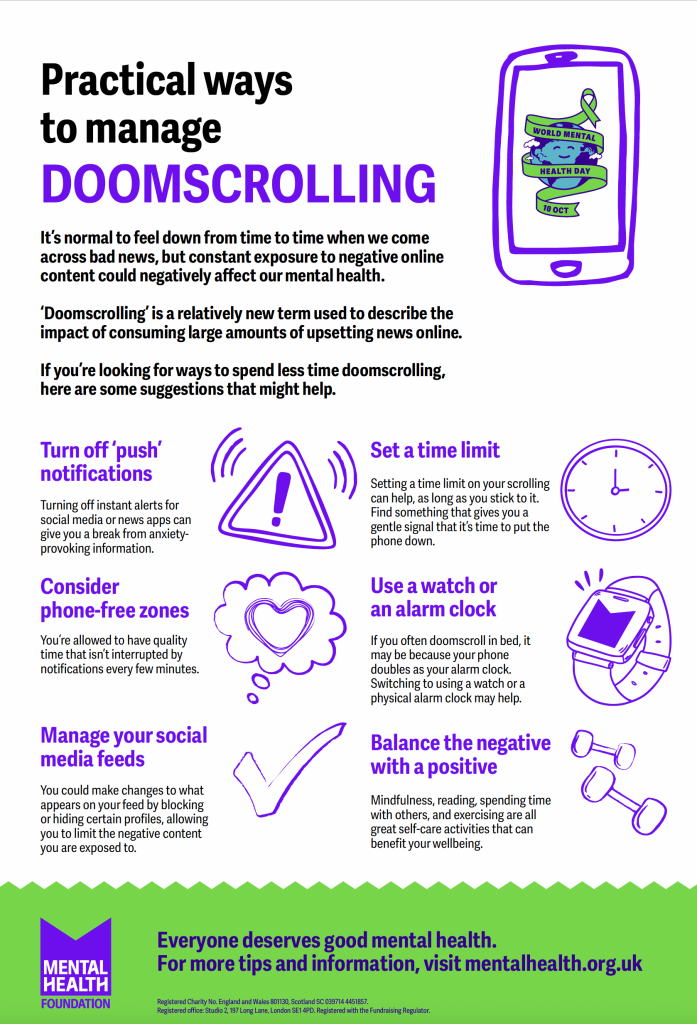We all know what it feels to get lost scrolling the internet. I know personally how a quick scroll of my social media feed can often become a lengthy trip down a virtual rabbit hole. But do you notice how you feel after you’ve finished scrolling – are you rested, refreshed or calm? Or do you feel more tense, heavier or wired?
The word ‘doomscrolling’ has become part of modern-day vocabulary. It’s something I regularly talk to clients about in my counselling practice. This is especially the case with clients struggling with depressed mood, anxiety, poor body image or low self-esteem. It’s common to hear they use scrolling to have a break from how they feel, or that they open their phone whenever they can’t concentrate on work, study or their to do list.
Why doomscrolling feels like a treat
Scrolling the internet can offer us an escape. It provides access to information, resources and a world beyond our own. It can offer a window into a life we’d love, a body we think would make us happy and people who we think are inspiring.
The internet and technology have brought the world to the palm of our hands. It’s easy to lose sight of what a privilege it is for us to have access to resources, information, products and services across the globe, 24/7.
The positive aspects of this technology mean we have endless ways to communicate, connect and learn. It makes it possible to keep in touch with friends, family and contacts instantly, follow social media accounts that inspire us and broaden our knowledge through research on any subject we choose. Scrolling online can be a treat. A time to catch up on subjects we love and feel part of a greater entity.
How algorithms make scrolling irresistible
But the reality is we’re often being duped. What makes us find scrolling so irresistible is actually the algorithms. These are features media companies have developed to keep us hooked and help to ensure we keep scrolling. Much of what feels irresistible is the algorithm quietly learning what we linger on and feeding us more of it.
Online companies draw on key aspects of psychological theory, such as how our reward systems are activated, in order to keep us engaged. Social media platforms and websites are designed to feed us more of what we desire. Therefore, what we engage with, we see more of. It’s not just our behaviour, a huge amount of time and money is spent to keep coming us back for more.
Why some people are more vulnerable
If you’re feeling low, anxious or unsure of yourself, scrolling can be both a distraction and a trigger. The internet offers endless opportunities for comparison. Many clients describe how they find themselves slipping into comparison comparing their body, appearance, lifestyle and success with others.
For people with low self-esteem or body image worries, spending a lot of time viewing other people’s lives can fuel and deepen insecurities. When your mood is low and you don’t feel good about yourself, the brain tends to focus more on information that reinforces these feelings. Studies suggest social media algorithms can increase the heightened cognitive distortions experienced by someone who is depressed by feeding back content aligned with these distortions1 .
Clients with eating issues often tell me they’ve used social media to learn from people with eating disorders. The algorithms keep serving up more of this type of content to them and they can get caught in a feedback loop. I have an interest in nutrition and often find myself bombarded with feed after feed with all kinds of tips about diet and nutrients. I find this can become confusing and overwhelming and I understand how this all works.
The doomscrolling paradox
The paradox is that scrolling can feel soothing or distracting in the moment. It can genuinely feel like downtime. But the more it becomes your go-to treat, the greater the risk of it spiralling into negativity. I know from own past experience that when I’ve spent a lot of time scrolling online, especially social media, my mood can become subdued.
Prolonged exposure to comparison or negative content can backfire and worsen mood. Research shows doomscrolling is positively associated with psychological distress, which in turn predicts lower life satisfaction and wellbeing2 . When low mood or self-esteem leads to doomscrolling, you can be more exposed to negative content which can cause your mood to decline further.
Here are some insights I’m likely to hear from my clients about their scrolling patterns.
– I just can’t focus on what I have to do, instead I scroll and the ‘to do’ list gets longer
– I know I use my phone as a distraction, hours can pass and I’m not feeling any better
– I stay up late scrolling, I know it’s not good but I can’t stop. Then in the morning, I struggle to get up.
– I compare myself to a lot of people online. Looking at their lives makes me feel so inadequate.
How doomscrolling impacts sleep and isolation
Doomscrolling can impact our sleep, focus and wellbeing. Our devices can become the thing we turn to when we feel bad but also reinforce our negative feelings.
Scrolling can also have a negative impact on our sleep. I often work with clients who have sleep issues. When we discuss their sleep hygiene, they commonly are spending time online before bed. Exposure to blue light from screens before bed can suppress melatonin, making it harder to switch off and sleep. This can further disrupt our mood and recovery.
I often notice how clients who are doing a lot of doomscrolling are also isolated. Feeling low, anxious or insecure can make you less inclined to socialise. So, when scrolling becomes your go-to soothing activity, it can make you go inward. I witness how this can make people less social and in turn less inclined to tell others how they feel.
Practical ideas to reduce doomscrolling
I support clients to put in place small changes to reduce their scrolling and make it more beneficial.
Below are helpful suggestions of how to reduce doom scrolling from the Mental Health Foundation.

Conclusion
Scrolling for pleasure may feel like a harmless treat but can become problematic. If you are already experience anxiety, low mood, low self esteem or body image issues, you may be more at risk of doomscrolling.
It can be helpful to notice your patterns of behaviour, monitor the time you spend online and check how your mood fluctuates. If you’ve spent a lot of time online recently, reflect on whether it’s having a positive or negative impact.
If you think it would be helpful to reduce your time online, why not pick a suggestion that appeals and try it out. Give it some time and monitor how it makes a difference.
1 Bathina, K. C., ten, T. M., Lorenzo-Luaces, L., Rutter, L. A., & Bollen, J. (2020). Depressed individuals express more distorted thinking on social media. ArXiv.org. https://arxiv.org/abs/2002.02800?utm_source=chatgpt.com
2 Satici, S. A., Gocet Tekin, E., Deniz, M. E., & Satici, B. (2022). Doomscrolling Scale: its Association with Personality Traits, Psychological Distress, Social Media Use, and Wellbeing. Applied Research in Quality of Life, 18(2), 833–847. https://doi.org/10.1007/s11482-022-10110-7





